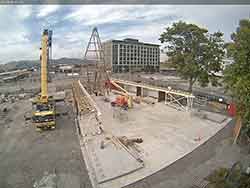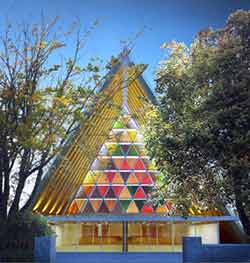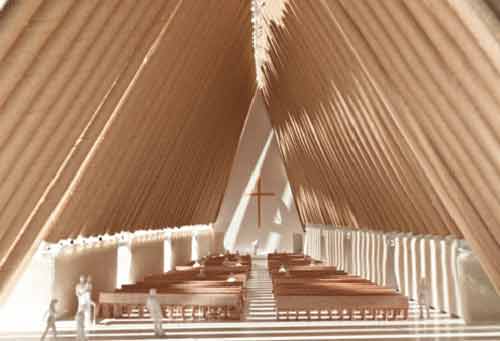This post will move from local points to general principles that, hopefully, you can find relevance for in your own context – wherever you are.
Outside the park-like green frame that will encircle the new central city of Christchurch, and sited in what will be the car-park for the planned city’s new stadium, is rising (possibly at the slowest rate imaginable) the “Transitional Cathedral”. Originally planned as a relatively inexpensive cardboard building that was to have been put up in three months, the building is now looking to be pretty permanent, uncertain of its funding, and with it now being steel clad in cardboard, the cardboard being added to keep faith with the original promise, and hopefully drawing droves of money-giving visitors interested in possibly a world first: a permanent building covered in cardboard.

As the foundations are in place, and the first outlines are becoming apparent, I am particularly interested in the number of people who are commenting to me and asking about its unusual “orientation”. This includes locals, people who have little interest in or knowledge about church, visitors, and tour operators. Christchurch in Canterbury, NZ, is an Anglican settlement (the only one in the world?) The central city was laid out in a grid aligned to the points of the compass with all churches clearly following the tradition of facing East (See Architectural Design Guidelines posts on this here and here). The Transitional Cathedral faces South (I can find no explanation for this on its dedicated website).
Others are waiting to see how this first church building since the quakes will express the Architectural Design Guidelines that the diocese has adopted. There is also a particular burden and privilege on a cathedral community to set the standard in worship – not that its liturgy be cloned in other communities, but that it express liturgical principles in a manner that others can enthusiastically emulate.
Begin planning from the inside out
The last church building to be built prior to the quakes was built as a “churchy looking” shell and then filled with furnishings and finally opened for people. It is an order of doing things that is fraught with problems and can result in debilitating and patently unnecessary compromises.
My sincere and expressed hope had been that, with the new opportunities provided since the quakes, we would plan our church buildings the other way around – from inside to out. The church is primarily the people. We have furnishings, rites, signs and symbols. And finally we encase these all in a shell (the church building) – to stop the church (us) from getting wet (or sunburnt).
We have for so long been re-ordering inherited buildings for renewed worship (where that shell is essentially fixed) that I regularly have to explain to people why, when we are starting to build ex nihilo, we do so starting from the inside out. When we go to build a house, we start not from a shell and then see what we put where, we decide, for example, whether it will it be a one-bedroom flat with on-street parking, or will it be a four-bedroom home with en-suites, lounge, living, study, and dining rooms, and double garages?
It is irritating enough, as just one example, to have toilet and kitchen concerns to deal with in an inherited building, but this should never arise as even an issue in a new build. [Our commitment to biculturalism and multiculturalism (as well as rediscovery of pakeha culture) is a Key Theme in the diocesan Architectural Design Guidelines].
Many communities are finding, as they worship in a hall (for example) with flexible possibilities, that they are (finally) discovering renewed worship through freedom from the inherited building. It is to be earnestly hoped that these communities will start from this experience and design their new building around this insight. One of the problems with the cathedral community, of course, is that they worshipped for more than a century in the cinema-seating-style in their nineteenth century building, and are following this seating configuration in each of the subsequent buildings in which they are worshipping.
Once one has the concept and then the plan of the community gathered around the (squarish) table, one needs to work out where the presider’s, assistants’, and servers’ chairs, lectern, possible pulpit, immersion font, music and other leaders including any choir, organ and other instruments, all are arranged.
“Transcendence and Intimacy” is another Key Theme, for (for example) small or weekday services. Then there are the requirements of hospitality, refreshments, vestries, and offices.
Only then, after the location for all that is needed has been worked out, only then do we start to work out how to keep this from the rain, and design the roof and walls, the shell to contain it. After this there is the opportunity to add (even traditional) external distinguishing features – eg. a spire, a cross, a bell tower.
 Meanwhile, the deconsecrated cathedral in the Square is subject to High Court discussion, and has proposals which vary from replacing it with a fountain on which the previous building is projected, restoring it to what it was, a mayoral proposal to stabilise it and cover it in glass, to a church leader suggesting more than once the value of exploring an ecumenical building.
Meanwhile, the deconsecrated cathedral in the Square is subject to High Court discussion, and has proposals which vary from replacing it with a fountain on which the previous building is projected, restoring it to what it was, a mayoral proposal to stabilise it and cover it in glass, to a church leader suggesting more than once the value of exploring an ecumenical building.
If you are interested in further posts on architectural principles:
The community
The cross
The altar
The font
The ambo/lectern/pulpit
The presider’s chair and the cathedra
The transitional cathedral
Achitectural Design Guidelines 1
Achitectural Design Guidelines 2
Achitectural Design Guidelines 3
Achitectural Design Guidelines 4
eating in church
If you appreciated this post, there are different ways to keep in touch with the community around this website: like the facebook page, follow twitter, use the RSS feed,…




I am rather flattered to be described as a “church leader” 🙂 Not least because, on the matter of our cathedral(s), I have no leadership role, save for being a member of the our local diocesan synod. And I have never had feedback to suggest that when I proffer an opinion about the future of our cathedral(s), I am some how a “leader” because it is a “leading opinion”. Mostly I think people tolerate my ideas as interesting eccentricities and then move to the next part of the conversation. So I guess I am doubly flattered, Bosco, to have my opinion treated so respectfully by you!
Peter, I always treat your opinions with respect (reserving that respecting and agreeing are not synonyms), and, yes, I regard you as a church leader, even a significant one. Blessings.
Creatio ex nihilo architecturo.
Steel with a cardboard exterior to camouflage the lie! That sounds a bit more permanent than the original intent.
My understanding, Br David, is that NZ could not (easily) produce the thickness/strength of cardboard of the original concept. Blessings.
One of the most exciting liturgies I ever went to was at Pentecost in St Gregory of Nyssa in San Francisco. The building was extraordinary in the way it underscored the liturgy and celebration. Visit if you get the chance.
Thanks, Rosemary. In my 2005 Study Leave I went out of my way to go to St Gregory’s. You are quite right – the building is a wonderful example of planning from the inside out. Blessings.
Wow, Father B, I just saw the options for the rebuilding of the Christchurch Cathedral downtown! The idea for a new contemporary cathedral is stunning. I so hope that approach is what is chosen. But if folks are pushed to the more traditional, I hope beyond hope that they take the reinterpretation, rather than the stodgy reproduction of the original building and being shackled to it’s shortcomings.
BTW, Happy Birthday to Jesus! For you lot, today is already the 183rd anniversary of the founding of the LDS Church and the day Mormons that believe that Jesus was actually born. They will be gathering in Salt Lake City this weekend for General Conference and live streaming and beaming the proceedings to LDS chapels all over the world, live from the 21,000 seat LDS Conference Center.
Yes, Br David, the options are the talk of the town at the moment; so I’m letting things settle a bit and may yet write a post on this. Easter Season Blessings.